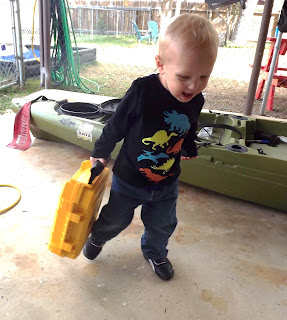Here are the step by step instructions, showing how I installed it:
Step 1
Gather the parts and tools that you will need. The anchor trolley system I bought came as a kit with all the pieces that I needed included.The only tools that you should need are a phillips screw driver, and a drill with a 3/16th and 3/8th inch bits, and a ratchet (not pictured.) I also used some marine grade silicon sealant.
Step 2
Decide where you want to install the pulley at the rear of the kayak. I chose to install it about 12 inches from the end of the kayak.Be sure you install the pulley above the waterline to reduce the likelihood or severity of a potential leak (since you will be drilling holes.)
Use the holes in the pulley as a template for the holes that you will drill.
Step 3
Drill two 3/16th inch holes for the bolts to go through.Step 4
Attach the pulley with the provided nuts, washers, and bolts.I applied a small amount of sealent to each hole and bolt before I attached the pulley. This is not necessary according to the instructions; however, I felt that it would help prevent any leaking.
You will need to reach inside of the kayak to install the washers and to tighten down the nuts and bolts.
Step 5
Select a spot on the front end of the kayak where you would like to install the front pulley.Repeat steps 2 - 4 to install the front pulley.
Step 6
Do not tie anything off, this is just to determine the placement of any needed rope guides.
The guides will help to keep the rope running along the side of the kayak, and out of your way.
Step 7
I determined that I needed to install two rope guides.
One is towards the front of the kayak, just a couple inches forward of the rod stagers.
The second was toward the back of the kayak, just behind the seat.
Step 8
After you determine where each guide will be installed, drill a 3/8 inch hole for the anchor to slide into.
Step 9
Run the rope through the guides before you go any further. Running the rope through the guides now (before they are screwed to the kayak) will be much easier.
This picture does not show this step, but it does show how the rope will run through the guide.
Step 10
Slide the provided anchor into the how you just drilled.
I applied a small amount of sealant to the hole and around the anchor before I pushed the anchor in. This isn't necessary, but I did so for my own sanity.
Step 11
Screw the guide into the anchor using the provided screws. As you screw the guide in tighter, the anchor will expand, securing the guide to the kayak, and providing a water tight seal.
Step 12
With the rope running through the guides that are already installed on the kayak, run each end of rope back through the pulleys.
Run the loose end up from the bottom, and pull each end of rope together, all the way though the pulleys.
Step 13
Tie one end of the rope to the provided bungee chord.
I used a "fisherman's knot" to secure the rope to one loop on the bungee.
Step 14
A few inches above the bungee chord, attach the provided anchor clip.
Don't tie the clip up, just run the rope through the slot on the clip as shown.
Then take the loop you made and flip it back over the top of the clip, so that the loop runs around it and locks it to the rope.
Then take the loop you made and flip it back over the top of the clip, so that the loop runs around it and locks it to the rope.
Step 15
Take the remaining loose end of rope (the end not tied to the bungee) and run it though the loop on the other end of the bungee. Pull tight enough to put tension on the bungee (but not stretching the bungee too far), tie the rope to the bungee using the same knot.
You should be left a continuous loop that runs though your guides, the pulleys, and is tied to both ends of the bungee chord. Make sure the rope is tight, but not stretching the bungee chord very much.
Step 16
Once the rope is tight, and set up like you like it, cut off the excess rope, burn the end to prevent fraying and you are done!
Related posts:

















Hi Pat and thanks for sharing this install. I've watched a few other anchor trolley install videos online and I've seen more then one person run the "free" line through the ring (or anchor clip). It works to hold both lines close to each other, much like I suspect the rope guides you used would work. Any thoughts on that process?
ReplyDeleteI ask because doing it that way would result in 2 less holes in the boat.
Thanks
If i am picturing this correctly in my head, I would assume that doing this would lead to both sides of the rope going out towards anchor when the anchor is down. I don't think that this would be a big problem, as long as you can reach it to move the anchor around. I think some people would prefer to do this to eliminate drilling extra holes. Maybe?
Delete